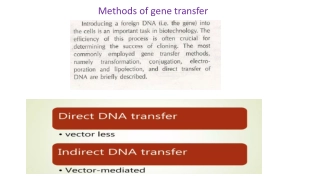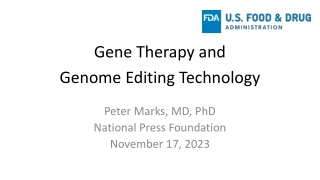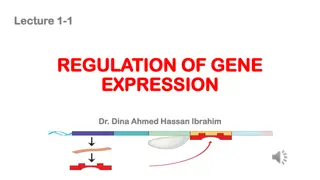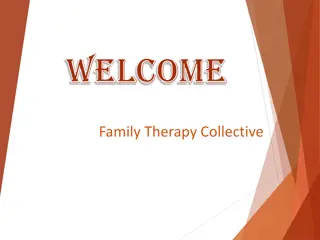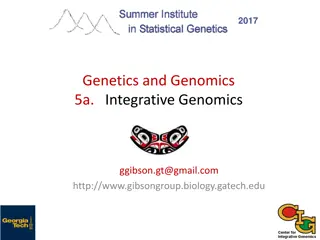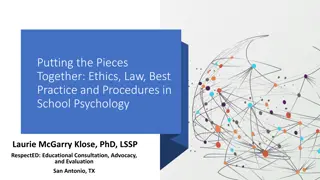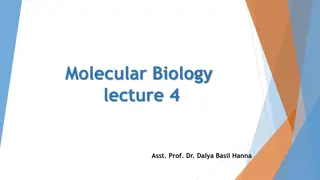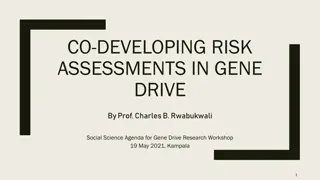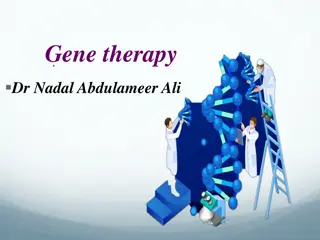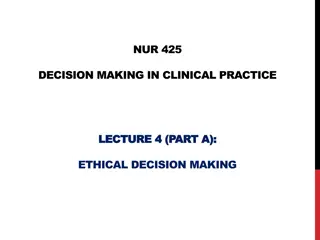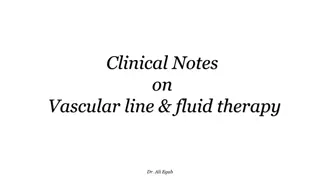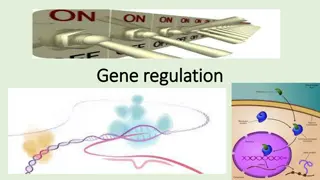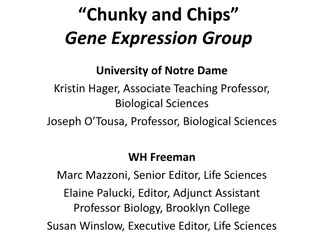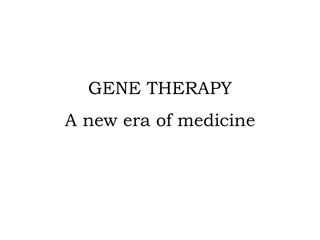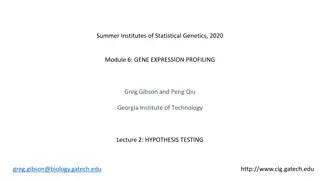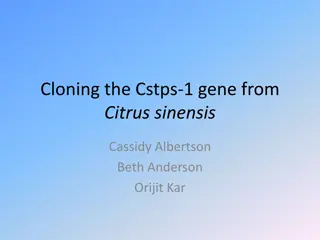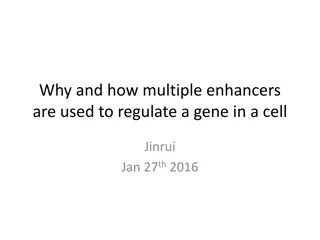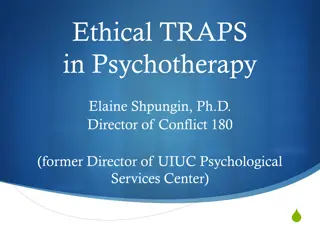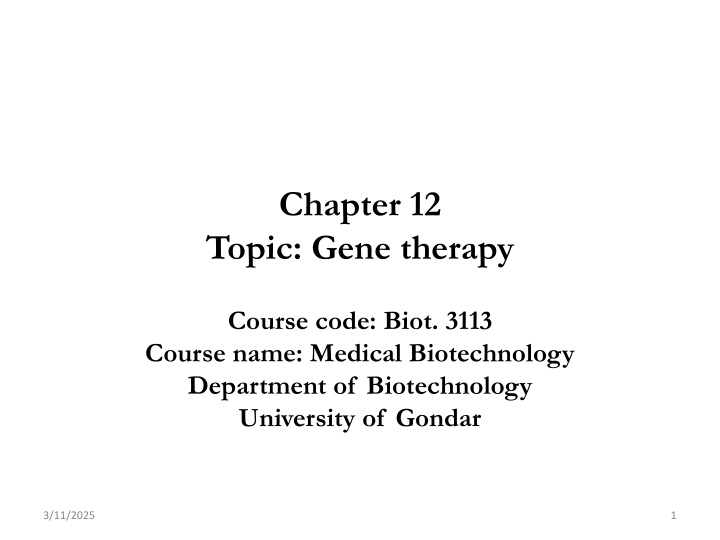
Gene Therapy: Advancements and Ethical Considerations
This content delves into the world of gene therapy, discussing the types, vectors, methods, and early human experiments. It touches on somatic and germline gene therapy, various vectors used, and a glimpse into the history of human gene therapy trials. Ethical issues surrounding germline therapy are highlighted, along with the current status of gene therapy experimentation. Discover the promises and challenges of gene therapy in the medical biotechnology field.
Download Presentation

Please find below an Image/Link to download the presentation.
The content on the website is provided AS IS for your information and personal use only. It may not be sold, licensed, or shared on other websites without obtaining consent from the author. If you encounter any issues during the download, it is possible that the publisher has removed the file from their server.
You are allowed to download the files provided on this website for personal or commercial use, subject to the condition that they are used lawfully. All files are the property of their respective owners.
The content on the website is provided AS IS for your information and personal use only. It may not be sold, licensed, or shared on other websites without obtaining consent from the author.
E N D
Presentation Transcript
Chapter 12 Topic: Gene therapy Course code: Biot. 3113 Course name: Medical Biotechnology Department of Biotechnology University of Gondar 3/11/2025 1
Objectives: Gene Therapy Germline vs. somatic gene therapy Gene therapy vectors (advantages and disadvantages): Retrovirus Adenovirus Adeno-associated virus (AAV) Non-viral vectors in vivo vs ex vivo gene therapy Current status of human gene therapy experimentation 3/11/2025 2
Early Human Gene Therapy Experiments Marty Cline human experiments-- 1980 NeoR/TIL marking studies-- 1989 ADA/peripheral blood T cells-- 1990 LDL receptor/ex vivo hepatocytes-- 1992 HLA-B7 Melanoma-- 1992 ADA/bone marrow, cystic fibrosis, multiple cancer protocols, HIV October 1999-- 1st reported death due to gene therapy November 1999-- Failure of scientists to report gene therapy trial deaths to FDA/RAC April 2000-- 1st definite success of human gene therapy (SCID-X1) Cavazzana- Calvo, et al. Science 288:669. Factor IX gene therapy (hemophilia B) ? promising In vivo AAV: Kay et al. Nat. Gen. 24:257, 2000. Ex vivo fibroblast: Roth et al. NEJM 344:1735, 2001. 3/11/2025 3
There are two different types of gene therapy depending on which types of cells are treated: Somatic gene therapy: transfer of a section of DNA to any cell of the body that doesn't produce sperm or eggs. E.g.: cells of the bone marrow Germline gene therapy: transfer of a section of DNA to cells that produce eggs or sperm. Germline therapy insertion of the gene into the reproductive tissue in such a way that the disorder in his or her offspring would also be corrected. But germline therapy have ethical issues!!!! 3/11/2025 4
Gene Transfer Methods Retroviral vectors Lentiviruses Adenovirus Adeno-associated virus (AAV) Other viral vectors Vaccinia Herpes virus Polio virus Papilloma virus Sindbis and other RNA viruses Non viral methods Ligand-DNA conjugates Adenovirus- ligand-DNA Lipofection CaPO4 precipitation Ribozymes chimeric oligo/gene correction Hepatitis virus Direct DNA injection 3/11/2025 6
First identify the gene missing from a sick patient. Then head to the lab and create a modified virus that how a virus is used to deliver a gene into a patient that is missing that gene. includes that missing gene. 3/11/2025 7
Gene Therapy Vectors Advantages Vector Disadvantages Retrovirus High efficiency transduction of appropriate Potential for insertional mutagenesis. target cells. Requires dividing cells. Long-term expression- integration into Limited size of DNA insert. chromosomal DNA). Adenovirus High transduction efficiency. Transient expression. Broad range of target cells. Immunogenicity. Does not require cell division. Direct cytopathic effects of virus. Low risk of insertional mutagenesis. Adeno- associated virus (AAV) Does not require cell division. Potential for insertional mutagenesis if integration not site-specific. ? Site specific integration. Limited size of DNA insert. Non-viral vectors No infectious risk. Low efficiency. Completely synthetic. Limited target cell range. No limitation on insert size. Transient expression.
Adeno-associated virus AAV is a small virus that infects humans and some monkeys. AAV has become the preferred virus for the following reasons: only causes a mild immune response infects both dividing and non-dividing cells persists in cells without directly inserting into the host genome (remains in an extra-chromosomal state.) the carrying capacity of this viral vector is limited. This means it is not possible to insert large genes into an AAV. The size limit for AAV is debatable, but is generally listed between 4.5 to 4.9 kb. Scientists are currently trying to overcome this limitation. 3/11/2025 9
In addition to being safe and cost-effective, the most important properties of an efficacious gene transfer system will be; 1) target cell selective. 2) transcriptionally competent for the desired length of time. 3) available in a highly concentrated active form. 4) immunologically neutral. 3/11/2025 10
Problems Delivery of DNA Achieving high level expression Maintaining stable expression Tissue-specific expression in vivo regulation 3/11/2025 11
Gene Therapy: adding a normal gene to correct a specific gene disorder Two types of gene therapy: Ex vivo gene therapy Cells are removed from the patient, treated with techniques similar to transformation, and then reintroduced to the person time consuming and expensive In vivo gene therapy Introducing genes directly into tissues and organs in the body Challenge is delivering genes only to intended tissues and not tissues throughout the body. quick and inexpensive, targeting certain cells is difficult 3/11/2025 12 e.g., bone marrow stem cells
Gene Therapy 3/11/2025 13
Gene Therapy Vectors for Gene Delivery Rely on viruses as vectors Use viral genome to carry a therapeutic gene or genes and use virus itself to infect human cells, introducing the gene Adenovirus (common cold) Influenza virus (flu) Herpes virus (cold sores, some cause STD) Must make sure the virus has been genetically engineered so that it can neither produce disease nor spread throughout the body 3/11/2025 14
Gene Therapy Viral Infection of Human Cells Bind to and enter cells; release genetic material (usually DNA) into nucleus or cytoplasm Human cell now acts as a host to reproduce the viral genome and to produce viral RNA and proteins Make Good Vectors Efficient at infecting many types of human cells Retroviruses (HIV) permanently insert their DNA into host cell genome Some viruses infect only certain types of cells good for targeted gene therapy 3/11/2025 15
Other Gene Delivery Options Naked DNA DNA by itself that is injected directly into body tissues Liposomes small, hollow particles made of lipid molecules Packaged with gene and injected or sprayed into tissues New Approaches to Gene Therapy Antisense RNA Ribozymes RNA interference (RNAi) Spliceosome-mediated RNA trans-splicing Triplex helix oligonucleotide therapy 3/11/2025 16
Inhibition of translation of specific RNA by antisense nucleic acid molecules Promoter antisense cDNA poly A addition signal -antisense RNA complex mRN A antisense oligonucleotide 3/11/2025 17
Ribozymes: A. Hammerhead B. Hairpin 3/11/2025 18
RNA interference (RNAi) Double-stranded RNA molecules are delivered into cells where the enzyme Dicer chops them into 21-nt-long pieces called small interfering RNAs (siRNAs) siRNAs join with an enzyme complex called the RNA-induced silencing complex (RISC) RISC shuttles the siRNAs to their target mRNA where they bind siRNA-bound mRNAs are degraded so they cannot be translated into a protein 3/11/2025 19
RNA interference (RNAi) dsRNA sense antisense Binding of dsRNA-specific nuclease Nuclease-ssRNA complex Hybridizes to mRNA cleavage mRNA is cleaved! A cellular nuclease binds to the dsRNA cleaving it into ssRNAs of 21-23 nucleotides each. The nuclease-RNA oligonucleotide complex binds and cleaves specific mRNA. 3/11/2025 20
Gene Therapy 3/11/2025 21
First human gene therapy SCID patient in 1990 SCID is severe combined immunodeficiency Defect in gene called adenosine deaminase (ADA) Produces an enzyme involved in the metabolism of nucleotide dATP Accumulation of dATP is toxic to T cells Without T cells, B cells cannot recognize antigen and make antibodies Ex vivo gene therapy successful 3/11/2025 22
Cystic Fibrosis two defective copies of a gene encoding a protein called cystic fibrosis transmembrane conductance regulator (CFTR) Normal protein serves as a pump to remove chloride ions from cell Produced by many cells in the body skin, pancreas, liver, digestive tract, male reproductive tract, and respiratory tract Extremely thick sticky mucus in airways; infertility; extremely salty sweat 3/11/2025 23
3/11/2025 24
Challenges Facing Gene Therapy Potential risks of viruses as vectors Death of Jesse Gelsinger in 1999 due to complications related to adenovirus vector Death of 2 children in France in 2002 Temporary cessation of a large number of gene therapy trials and FDA stopped most retroviral studies Greater patient monitoring 3/11/2025 25
Challenges Facing Gene Therapy Can gene expression be controlled? Can we safely and efficiently target only the cells that require the gene? How can gene therapy be targeted to specific regions of the genome? How long will therapy last? Will immune system reject? How many cells need to be corrected? 3/11/2025 26
ADA Deficiency Rare Immunodeficiency (fatal in childhood) Advantages as model for gene therapy: Regulated expression not necessary Low level expression sufficient Site of synthesis not critical Potential for in vivo selection Bone marrow suitable target Problems: Difficulty achieving high level, stable expression Other effective therapy: PEG-ADA therapy, allogeneic/haploidentical Bone Marrow Therapy First human experiments performed 1991 (2 patients) ?successful; simultaneous PEG-ADA therapy 3/11/2025 27
Glycogen storage disease type 1 (GSD-1) Cause: Autosomal recessive deficiency of G6Pase and glucose-6- phosphatase (G6Pase) system transporter (G6PT) cause GSD-1a and GSD-1b, respectively. Features: growth retardation, hypoglycemia, hepatomegaly, kidney enlargement, hyperlipidemia, hyperuricemia, and lactic acidemia. GSD-1b also have chronic neutropenia, functional deficiencies of neutrophils and monocytes, recurrent bacterial infections, 3/11/2025 28 ulcerations of the oral and intestinal mucosa
Consider somatic vs germline gene therapy; the later is currently banned. Note that gene therapy is limited to somatic cells and disorders that are caused by a single gene. 3/11/2025 29
Disease Target cells Transfected gene(s) Hemophilia A Hemophilia B Liver, muscle, bone marrow cells, fibroblasts Factor IX Factor VIII Familial hypercholesterolaemia Severe combined Bone marrow cells, T cells immunodeficiency Liver LDL receptor Adenosine deaminase Hemoglobinopathy Red blood precursor cells alpha-globin, beta-globin Cystic fibrosis lung airway cells CFTR Gaucher disease Cancer 3/11/2025 Bone marrow cells Glucocerebrosidase macrophages Tumor cells p53, Rb, interleukins growth-inhibitory genes, apoptosis genes` 30
ex vivo gene therapy approach for hemophilia A (factor VIII): Factor VIII production is not regulated in response to bleeding Only need to raise levels a little bit, not to 100%, as low levels of the Factor VIII can be beneficial to the patient Broad therapeutic index of factor VIII minimizes risk of overdose Delivery of factor VIII into the bloodstream does not require cell-specific expression 3/11/2025 31

